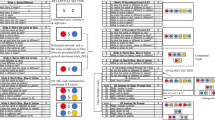Abstract
Two experiments examined the performance of preschool children in tasks requiring the generalized matching of faces to faces and names to faces tinder the control of instructional stimuli (background color) that specified the basis by which faces were to be matched on a given trial. The children first learned to recite all the names, and to select all the faces, in a fixed order (the forward order). They then learned to select the faces in response to their spoken names. When the faces appeared on a white background, subjects selected the face named. On a gray background, they selected the face whose name was next forward. Subsequently, over a series of tests, when subjects were presented with novel, but similar stimuli with the same names, and with completely novel stimuli with novel names, control by the white and gray background colors generalized. In the second experiment, on trials with the gray background, when the face bearing the next-forward relation was not present, the children learned to select an appropriate substitute (two faces forward). This performance also generalized to novel stimuli. Together with earlier findings, these data suggest that widely generalized relational matching performances may arise because the labels for these relations are generically and metaphorically extended tacts.
Similar content being viewed by others
References
Bruner, J.S., Olver, R. R., & Greenfield, P. M. (1966). Studies in cognitive growth. New York: John Wiley.
Hayes, S. E. (1991). A relational control theory of stimulus equivalence. In L. J. Hayes & P. N. Chase (Eds.), Dialogues on verbal behavior (pp. 19–40). Reno, NV: Context Press.
Inhelder, B., & Piaget, J. (1964). The early growth of logic in the child. New York: Norton.
Kendler, T. S. (1950). An experimental investigation of transposition as a function of the difference between training and test stimuli. Journal of Experimental Psychology, 40, 552–562.
Lowenkron, B. (1984). Coding responses and the generalization of matching-to-sample in children. Journal of the Experimental Analysis of Behavior, 42, 1–18.
Lowenkron, B. (1988). Generalization of delayed identity matching in retarded children. Journal of the Experimental Analysis of Behavior, 50, 163–172.
Lowenkron, B. (1989). Instructional control of generalized relational matching to sample in children. Journal of the Experimental Analysis of Behavior, 52, 293–309.
Lowenkron, B., & Colvin, V. (1992). Joint control and generalized nonidentity matching: Saying when something is not. The Analysis of Verbal Behavior, 10, 1–10.
Partington, J. W., & Bailey, J. S. (1993). Teaching intraverbal behavior to preschool children. The Analysis of Verbal Behavior, 11, 9–18.
Sidman, M. (1986). Functional analysis of emergent verbal classes. In T. Thompson & M. D. Zeiler (Eds.), Analysis and integration of behavioral units (pp. 213–245). Hillsdale NJ: Lawrence Erlbaum Associates Publishers.
Skinner, B. F. (1957). Verbal behavior. New York: Appleton-Century-Crofts.
Skinner, B.F. (1969). The inside story. In B. F. Skinner, (Ed.), Contingencies of reinforcement: A theoretical analysis (pp. 269–297). New York: Appleton-Century-Crofts.
Spence, K. W. (1937). The differential response in animals to stimuli varying within a single dimension. Psychological Review, 43, 427–449.
Steele, D., & Hayes, S. C. (1991). Stimulus equivalence and arbitrarily applicable relational responding. Journal of the Experimental Analysis of Behavior, 56, 519–555.
Author information
Authors and Affiliations
Additional information
This research was supported by a grant (HD 23123) from the National Institute of Child Health and Human Development. Our appreciation to Pam Kisor, Director of the Anna Bing Arnold Children Center, for her help and cooperation in coordinating subject participation. Portions of this research were conducted by the second author, under the guidance of the first, in fulfillment of the requirements for the Masters of Science degree in the Applied Behavior Analysis Option in Psychology at CSULA.
An erratum for this article can be found at http://dx.doi.org/10.1007/BF03392911
Rights and permissions
About this article
Cite this article
Lowenkron, B., Colvin, V. Generalized instructional control and the production of broadly applicable relational responding. Analysis Verbal Behav 12, 13–29 (1995). https://doi.org/10.1007/BF03392894
Published:
Issue Date:
DOI: https://doi.org/10.1007/BF03392894




